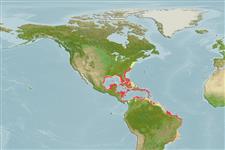Environment: milieu / climate zone / Tiefenbereich / distribution range
Ökologie
seewasser riff-verbunden; tiefenbereich 3 - 70 m (Ref. 13121), usually 5 - 20 m (Ref. 13121). Tropical; 41°N - 29°S, 100°W - 28°W (Ref. 55200)
Western Atlantic: Massachusetts, USA to Santa Catarina, Brazil (Ref. 57756), including the Gulf of Mexico and Caribbean Sea. Eastern Central Atlantic: St. Paul's Rocks (Ref. 13121).
Length at first maturity / Size / Gewicht / Alter
Geschlechtsreife: Lm 12.4 range ? - ? cm
Max length : 16.0 cm TL Männchen/unbestimmt; (Ref. 9710)
Rückenflossenstacheln (insgesamt) : 12; Rückenflossenweichstrahlen (insgesamt) : 19 - 21; Afterflossenstacheln: 3; Afterflossenweichstrahlen: 16 - 17. With two broad black bars on side of body and a third bar basally in soft portion of dorsal fin which extends onto caudal peduncle; broad black submarginal bands in the median fins; pelvic fins black except for the spine (Ref. 13442).
Body shape (shape guide): short and / or deep; Cross section: compressed.
Maximum depth from Ref. 126840. Inhabit coral reefs. Occur singly or in pairs. Feed on polychaete worms, coral polyps, crustaceans and mollusk eggs. Oviparous (Ref. 205), monogamous (Ref. 52884). Form pairs during breeding (Ref. 205). Adults may form plankton-feeding aggregations of up to 20 individuals, and occasionally clean other reef fishes which join the group, such as grunts, parrotfishes and surgeon fishes. (Ref: 40093). Generally common (Ref. 9710).
Life cycle and mating behavior
Geschlechtsreife | Fortpflanzung | Ablaichen | Eier | Fecundity | Larven
Distinct pairing (Ref. 205). Monogamous mating is observed as both obligate and social (Ref. 52884).
Allen, G.R., 1985. Butterfly and angelfishes of the world. Vol. 2. 3rd edit. in English. Mergus Publishers, Melle, Germany. (Ref. 4858)
IUCN Rote Liste Status (Ref. 130435: Version 2025-1)
Bedrohung für Menschen
Harmless
Nutzung durch Menschen
Fischereien: kommerziell; Aquarium: Kommerziell
Tools
Zusatzinformationen
Download XML
Internet Quellen
Estimates based on models
Preferred temperature (Ref.
123201): 25 - 28, mean 27.2 °C (based on 158 cells).
Phylogenetic diversity index (Ref.
82804): PD
50 = 0.5000 [Uniqueness, from 0.5 = low to 2.0 = high].
Bayesian length-weight: a=0.02239 (0.01431 - 0.03503), b=3.02 (2.89 - 3.15), in cm total length, based on LWR estimates for this species & Genus-body shape (Ref.
93245).
Trophic level (Ref.
69278): 3.5 ±0.2 se; based on diet studies.
Widerstandsfähigkeit (Ref.
120179): hoch, Verdopplung der Population dauert weniger als 15 Monate. (Preliminary K or Fecundity.).
Fishing Vulnerability (Ref.
59153): Low vulnerability (10 of 100).
🛈
Nutrients (Ref.
124155): Calcium = 101 [52, 160] mg/100g; Iron = 0.827 [0.486, 1.386] mg/100g; Protein = 18.7 [17.5, 19.8] %; Omega3 = 0.13 [0.08, 0.21] g/100g; Selenium = 35.6 [19.6, 67.4] μg/100g; VitaminA = 50.6 [14.7, 171.2] μg/100g; Zinc = 1.36 [0.92, 1.97] mg/100g (wet weight);
